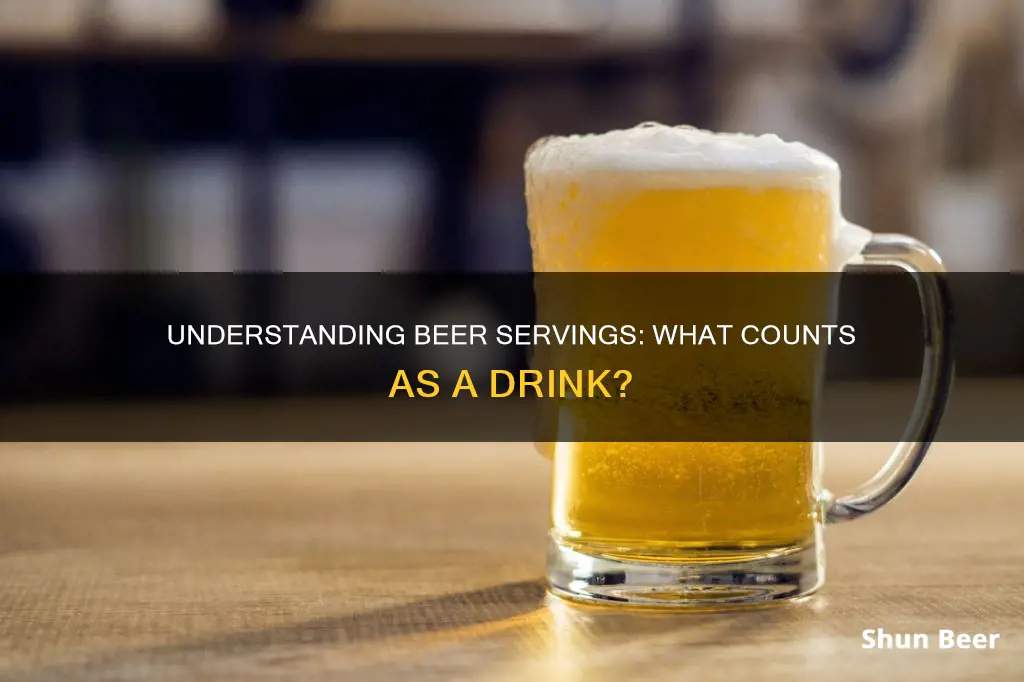
In the United States, a standard drink of beer is defined as 12 fluid ounces, which is typically one can or bottle. However, it's important to note that the alcohol content in beers can vary, with regular beers containing approximately 5% alcohol, light beers containing around 4.5%craft beers containing up to 8% or 9% alcohol. This variation in alcohol content can lead to different effects and impacts on the body, and it is crucial to understand how much alcohol is being consumed to make informed decisions about one's health and well-being.
| Characteristics | Values |
|---|---|
| Amount | 12 fl oz |
| Pure Alcohol Content | 0.6 fl oz or 14 g |
What You'll Learn

A standard drink is 12 fl oz of beer
It's worth noting that the amount of beer considered "one drink" can vary depending on the type of beer and its alcohol content. For example, malt liquor or flavoured malt beverages, such as hard seltzer, are typically served in a 12 oz glass but are considered one drink at 8-10 fl oz due to their higher alcohol content.
The definition of a "standard drink" is important for understanding and following health guidelines related to alcohol consumption. The National Institute on Alcohol Abuse and Alcoholism provides guidelines for standard drink sizes across different types of beverages, including beer, liquor, and wine. These guidelines help individuals monitor their alcohol intake and make informed decisions about their drinking habits.
It's important to be mindful of the amount of alcohol you consume, as excessive drinking can lead to negative health consequences. Binge drinking, for example, is defined as consuming enough alcohol to raise your blood alcohol content to 0.08% or higher. This typically translates to about five drinks for men and four drinks for women in a span of about two hours. Regular binge drinking can increase the risk of accidents, falls, and long-term health issues such as irregular heartbeats and cancer.
Additionally, alcohol affects each person differently, and factors such as gender, mood, food intake, and physical condition can influence how quickly someone becomes intoxicated. Understanding what constitutes a standard drink can help individuals make more informed decisions about their alcohol consumption and maintain a healthy relationship with alcohol.
Beer After Covid Recovery: What You Should Know
You may want to see also

Beer contains 0.6 fl oz or 14g of pure alcohol
In the United States, a "standard drink" is defined as any beverage containing 0.6 fluid ounces or 14 grams of pure alcohol. This is also known as an alcoholic drink equivalent. While the drinks may differ in size, each contains approximately the same amount of alcohol and counts as one US standard drink or one alcoholic drink equivalent.
A standard drink of beer is 12 fluid ounces, which is one can or bottle. Most beers usually have about 5% alcohol. Light beers typically measure around 4.5% alcohol. However, with the rise in popularity of craft beers, their alcohol content has also increased. Some craft beers contain 8% or 9% alcohol, which means you may feel the effects after just one beer.
It is important to note that the percentage of pure alcohol, expressed as alcohol by volume (alc/vol), can vary within and across beverage types. While the standard drink amounts are useful for adhering to health guidelines, they may not align with customary serving sizes. For example, beverage servers may provide drinks with more or less alcohol than the standard. Therefore, it is crucial to be aware of what you are drinking and understand that one beer or cocktail may not equal one standard "drink".
The amount of alcohol in a drink can be different depending on how it is measured and served. For instance, a glass of wine is typically served as 5 fluid ounces, but wine glasses are often larger than this standard serving size, making it challenging to measure accurately. Similarly, cocktails can vary in their alcohol content depending on the recipe and the amount of liquor added.
The Cost of Beer vs Mixed Drinks: Which is Cheaper?
You may want to see also

Beer glasses are larger than the standard serving
In the United States, a "standard drink" is defined as any beverage containing 0.6 fluid ounces or 14 grams of pure alcohol. This is roughly equivalent to 12 fluid ounces of regular beer. However, it's important to note that alcoholic drinks vary in types, sizes, and alcohol content, and the way alcohol affects the body differs from person to person. Beer glasses are often larger than the standard serving size of 12 fluid ounces.
The National Institute on Alcohol Abuse and Alcoholism guidelines state that a standard drink of beer is 12 ounces, which is typically one can or bottle. Most beers used to contain about 5% alcohol, but with the rise in popularity of craft beers, some now have an alcohol content of 8-9%. This means you might feel the effects after just one beer.
The effects of alcohol depend on various factors, including gender, mood, food consumption, the speed of drinking, tolerance, physical condition, medication, carbonation, and altitude. Alcohol is a depressant, and while it may initially give you a feeling of energy, it affects judgment and inhibitions while slowing reaction times. It can also cause dehydration, leading to increased thirst and continued drinking.
It's important to be aware of what you are drinking and understand that one beer may not equal one standard "drink." The amount of alcohol in a drink can vary depending on how it is served and poured. For example, a wine glass is typically larger than the standard serving size of 5 ounces, making it difficult to measure and easy to exceed the recommended amount.
To ensure you are drinking responsibly and accurately measuring your alcohol intake, consider using a liquid measuring cup or filling a dry measuring cup to the appropriate level.
Is Non-Alcoholic Beer Safe for Children to Drink?
You may want to see also

Beer has around 5% alcohol, light beers have 4.5%
The alcohol content of beer varies depending on the type of beer. Beer typically has an alcohol content of around 5%, while light beers have slightly less at 4.5%. A standard drink of beer is defined as 12 fl oz, which is the equivalent of one bottle or can.
The amount of alcohol in beer can vary, especially with the rise in popularity of craft beers. Some craft beers can have an alcohol content as high as 8% or 9%, which means that a person may feel the effects after consuming just one beer. It's important to be aware of the alcohol content and the amount of beer you are consuming, as it can be easy to underestimate how much you have had.
The National Institute on Alcohol Abuse and Alcoholism provides guidelines for standard drink sizes to help individuals monitor their alcohol intake. According to these guidelines, a standard drink of liquor (such as rum, gin, or tequila) is 1.5 fl oz, and a standard glass of wine is 5 fl oz. However, wine glasses are often larger than the actual serving size, making it difficult to measure without a measuring cup.
The effects of alcohol can vary from person to person, depending on factors such as gender, mood, food intake, speed of consumption, tolerance, physical condition, and medication/drug interactions. It's important to understand how alcohol affects your body and to drink in moderation. The U.S. Dietary Guidelines for Americans define moderate drinking as one drink per day for women and two drinks per day for men, among legal drinking-aged adults.
Beer and Covid Shots: What You Should Know
You may want to see also

Craft beers have 8-9% alcohol
The amount of beer that is considered one drink varies depending on the type of beer and its alcohol content. In the United States, a "standard drink" is defined as any beverage containing 0.6 fluid ounces or 14 grams of pure alcohol. This is often referred to as one alcoholic drink equivalent or a "standard drink".
Craft beers, which are known for their higher alcohol content, can have an alcohol by volume (ABV) of up to 29%, with an average of 5.9%. However, it is important to note that not all craft beers have such high ABV levels. The average lowest ABV offering across 400 craft breweries in the United States was found to be 4.42%, with a range of 2.6% to 6.5% ABV.
When it comes to craft beers with 8-9% ABV, it is safe to assume that a 12-ounce serving of these beers would be considered one drink, as they fall within the range of regular beer servings. However, it is always important to be aware of the alcohol content and serving size of the specific craft beer you are consuming, as it can vary.
The higher alcohol content in craft beers is often associated with a richer, more complex taste that can be on the bitter side. This appeals to consumers who are drawn to the bolder flavors and the mouthfeel of stronger beers. Additionally, the higher ABV in craft beers gives them a longer shelf life, which is advantageous for both brewers and drinkers.
While the higher alcohol content in craft beers contributes to their unique taste and popularity, it is important to consume them in moderation. According to the 2025 Dietary Guidelines for Americans, moderate drinking is defined as one drink per day for women and two drinks per day for men among legal drinking-aged adults. Excessive drinking, including binge drinking and heavy drinking, can lead to increased health risks and negative consequences.
Beer and Keflex: Safe Mix?
You may want to see also
Frequently asked questions
A standard drink of beer is typically 12 fl oz (one can or bottle).
Yes, the alcohol content varies with different beers. Light beers contain around 4.5% alcohol, while craft beers can have up to 8-9% alcohol.
A standard drink of liquor (e.g. rum, gin, or tequila) is 1.5 fl oz, and a standard drink of wine is 5 fl oz.
In the United States, a "standard drink" is defined as any beverage containing 0.6 fl oz or 14 grams of pure alcohol.
Knowing what counts as "one drink" can help individuals monitor their alcohol intake and make better decisions for their health. It can be easy to lose track of how much alcohol one has consumed, especially when drinks are served in different sizes or with varying alcohol content.







